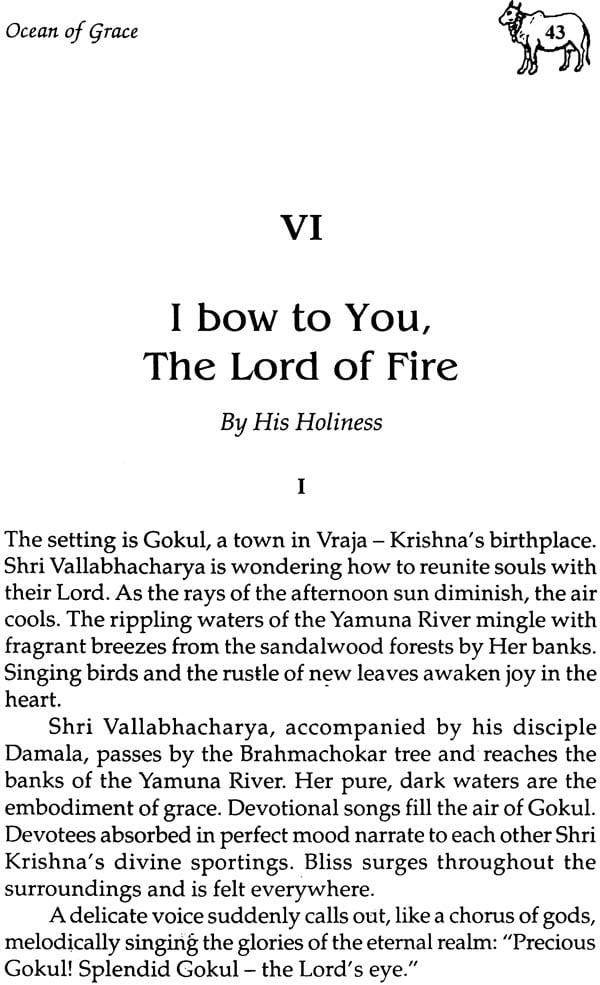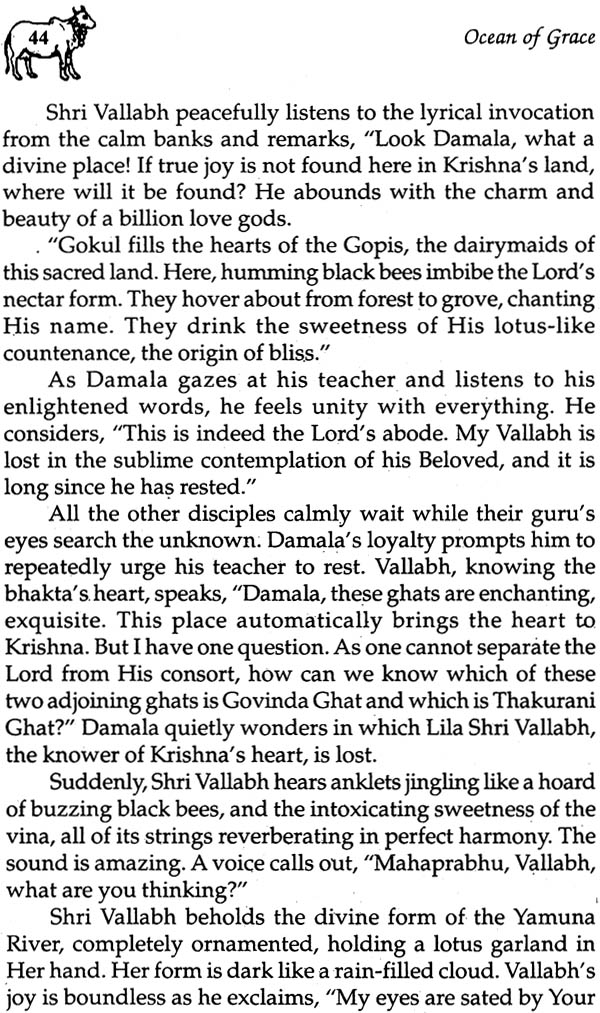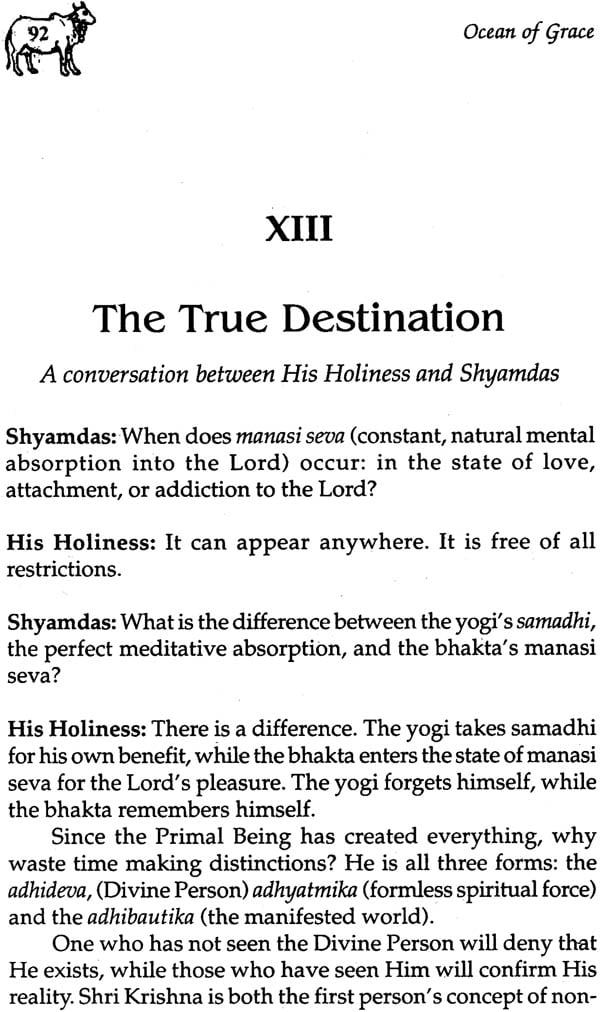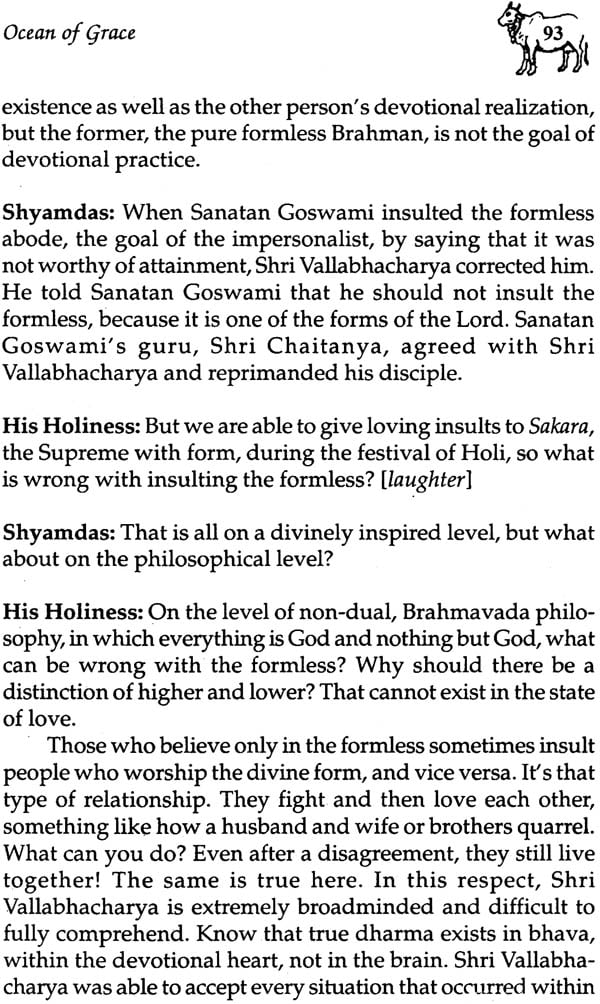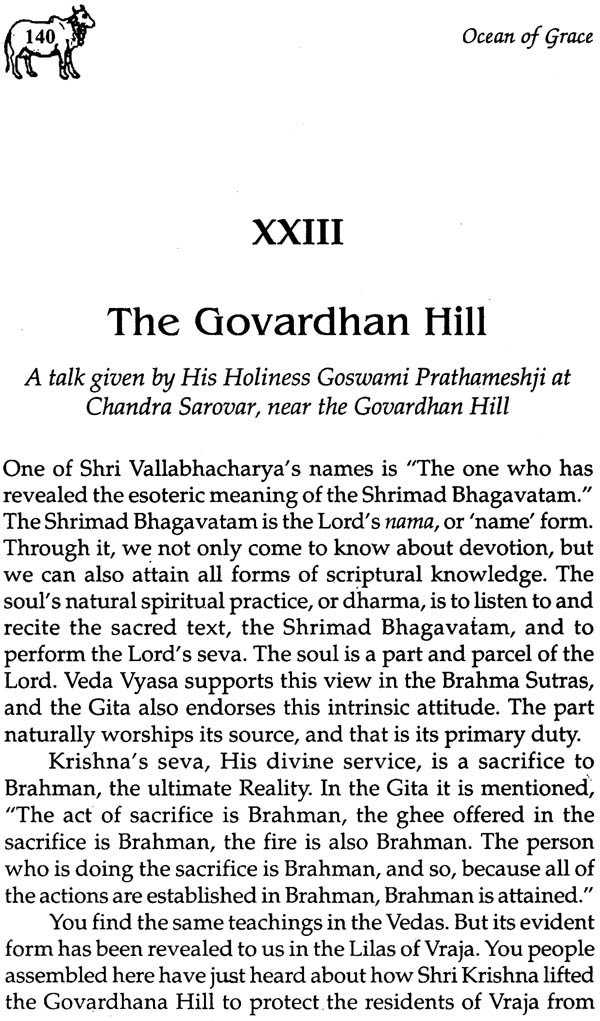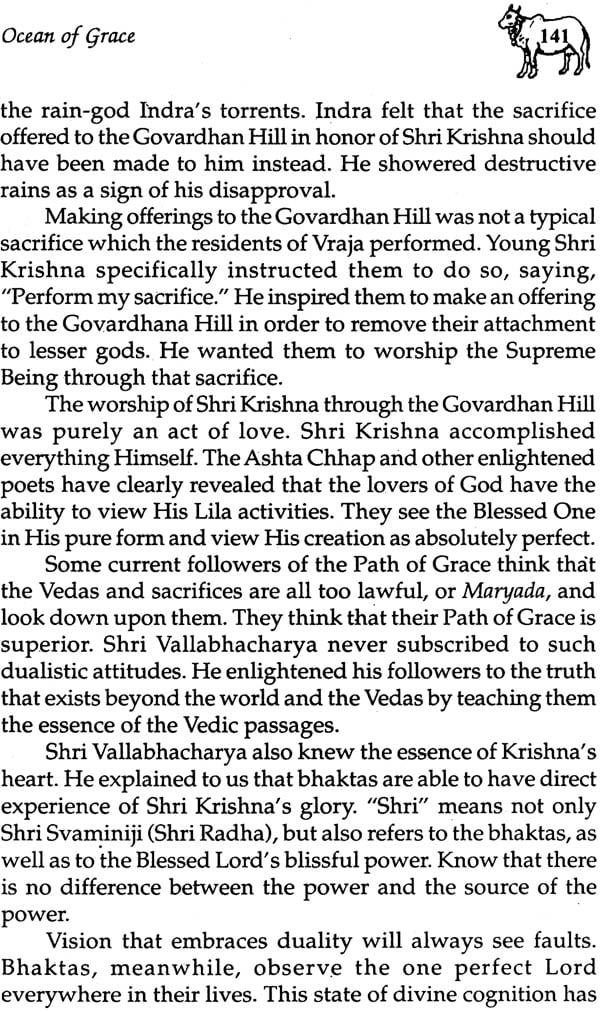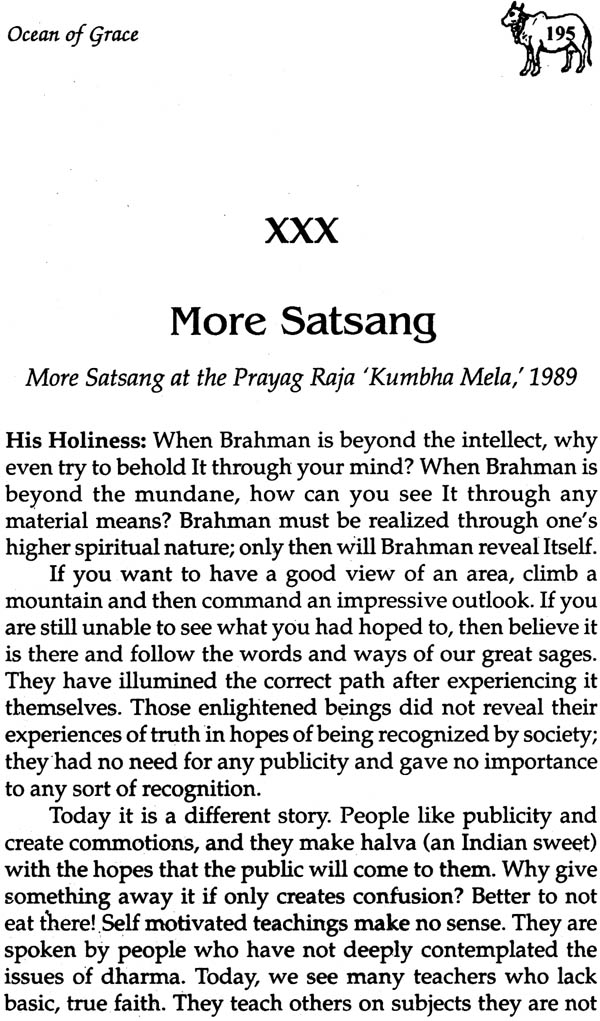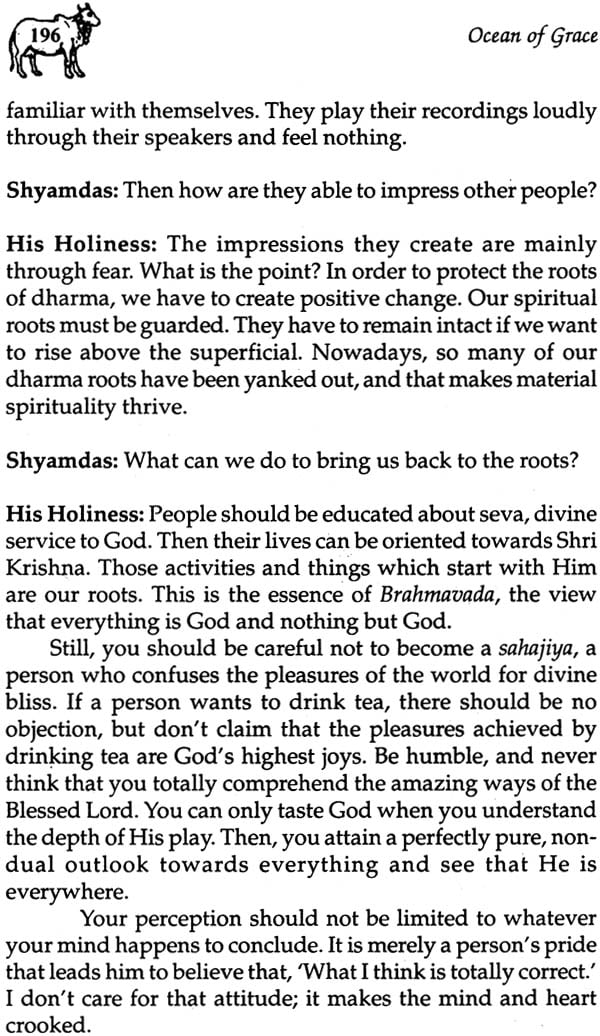
Ocean of Grace (The Teachings of His Holiness Goswami Shri Prathameshji)
Book Specification
| Item Code: | NAG612 |
| Author: | Shyamdas |
| Publisher: | Pratham Peeth Publications |
| Language: | English |
| Edition: | 2007 |
| Pages: | 224 (19 Color and 7 B/W Illustrations) |
| Cover: | Hardcover |
| Other Details | 8.5 inch X 5.5 inch |
| Weight | 420 gm |
Book Description
About The Book
Ocean of Grace reveals the priceless direct teachings of Goswami Shri Prathameshji, a pillar of the pushti marg (Path of Grace), renowned Dharma advocate, master musician, poet, and peerless teacher. Those dedicated to any devotional path will discover within His written and spoken teachings the invaluable guidance and wisdom of a genuine spiritual master. Shyamdas' written recollections of his beloved teacher, along with transcripts of their personal discussions, offer the reader additional insight into the precious relationship which exists between a guru and disciple.
About the Author
The author and translator, Shyamdas, lived and studied with his guru, His Holiness Goswami Shri Prathameshji, for eighteen years. Since the 1970s Shyamdas has resided in Vraja, the heart of sacred North India, He also spends several months of the year in Nathdvara, Rajasthan and in New York.
Shyamdas translates the Sanskrit, Hindi, Gujarati, and Vrajabhasha literary works of the Pushti Marg (Path of Grace) into English to create books filled with astounding poetry, accounts of grace-filled practitioners and saints, as well as ancient scriptures and commentary. These texts impart a clear vision of the non-dual philosophy and lineage of 15th century Bhakti Master Shrimad Vallabhacharya, forefather and guru of His Holiness Shri Prathameshji.
Introduction
I had the extreme pleasure of living with His Holiness Goswami Prathameshji, a direct descendant of Shri Vallabhacharya and the head of the first seat of the Vallabh Sampradaya, for eighteen years. Shri Prathameshji was widely considered to be a pillar of the Pushti Marg lineage and the foremost modern spokesperson to interpret the Path of Grace. Although his physical form disappeared from this world on January 4th, 1990, Prathameshji's devotional teachings remain with us. His knowledge was vast. He was a pundit of Ayurveda, Vedanta, as well as the Shrimad Bhagavatam. He was a master of Sanskrit, Urdu, Gujarati, and Brajabhasha languages and an accomplished classical musician.
Prathameshji masterfully played the tabla and pakhavaja drums, harmonium, sitar, flute, and even sarangi, but most of all, it is the way he sang Dhrupada-Dhamar devotional kirtan songs that still resonates throughout my being. He was a master of "Lila kirtan." His life and songs emerged from the eternal realm and somehow manifested here in this world. His being was full of Lila-mood. He often sang, in total ecstasy, poems written by great bhaktas who had actually seen and experienced Shri Krishna's Lila. As he once told me, "To sing of the Lilas of Hari is the fastest flight to God." He then added,
Prathameshji was a genius at putting such devotional poems, written in his native Brajabhasha tongue, into astounding classical musical compositions. The songs that emerged from his being took those of us around him to magical spiritual heights. To hear him sing allowed us to taste the divine essence, the bhava and movement of the Lila. He delicately placed each word of the poem so as to bring forth the meaning as well as a perfect balance of melody, rhythm and poetry. To sing like that is not a matter of knowing raga, tala and music, but of understanding God to an intimate degree.
Devotion arises when the bhava of the kirtan describing Shri Krishna's Lila is entered into. Like mantras that were seen by realized sages, the kirtans of the Path of Grace can only be truly sung when there is a Lila-awareness of their content. His Holinesswas a master of this enlightened style of singing.
One winter, I accompanied His Holiness Prathameshji on a pilgrimage by bus throughout South India visiting the places where Shri Vallabhacharya taught the Shrimad Bhagavatam over five hundred years ago. Most of our traveling was done at night. After everyone had gone to sleep, I would quietly observe His Holiness as he sat up towards the front of the bus. Using the sounds of the rattling vehicle as a tampura drone, he would sing Lila kirtans throughout the night, while the bhava of Radha and Shri Krishna's divine plays teemed from his being. His singing was never a concert, but rather, his private divine offering. While he sang his heart out, everything became like himself, totally attractive.
His Holiness' life was ecstatic chant in movement, always moving from one cycle of beats to another. Often, while sitting, his hands tapped away the beats of the pakhavaja drum, his right hand playing his right knee and his left hand creating the bass sounds with the sole of his right foot. His song arose with his mood, at any time, but was always accompanied by a profound Lila mood. He loved the evening raga Arano, but he could also sing twelve different versions of the Sarang raga. He was also a master of Khyal and Thumri styles of singing.
On the evening of His Holiness' birth on May 7th 1931, the outline of Shri Krishna's lotus footprints appeared, in red powder, on the floor of his father's temple courtyard in Jatipura. His father, Goswami Dwarkeshji Maharaja, commented at that time, "He will certainly be a very powerful lineage holder." By the time His Holiness was fifteen, he was already an accomplished pundit, speaker, and musician. J had the fortune of meeting him in his home in Jatipura, near Vrindavan, when he was forty-three years old. I was nineteen.
This meeting took place during my second year in India, in the fall of 1973. At the time, I was on Vraja Yatra, a walking pilgrimage around the holy land of Vraja, with a few thousand other bhaktas. I traveled together with my Vraja guide and teacher, a Gujarati bhakta named Mangaldas.
One day Mangaldas and I walked with the other pilgrims to the Moon Lake, the site of Shri Krishna's Rasa Lila dance. We camped there, just a few miles from His Holiness Prathameshji's home in Jatipura. It was to be a memorable day for me. That morning, I heard a celestial call come from the sky, filling my ears. The sound was so incredibly melodious and sweet, like nothing I had ever heard in this world. Although it seemed to be in English, it was actually celestial music. This is what I understood in that sound, spoken by the Supreme Beloved: "Now, it is time for you to leave Mangaldas. Today, you will move on."
I was amazed and filled with bliss. These were the clearest words I had ever heard, yet when I looked around, I was shocked to see that no one else had noticed the divine utterance! It was inconceivable to me that they could have not heard it. Later that afternoon, I found myself sitting before His Holiness Goswami Prathameshji for the first time. He warmly welcomed me into his temple and initiated me the following morning. From that day, his teachings, songs and presence filled my life. He offered me a room in his temple home. It was there that I learned to listen and then to sing.
His Holiness gave me many teachings and amazing explanations of his lineage, the blessed Path of Grace. Whenever he spoke, the meaning of the words filled my heart. My greatest pleasure was to be around him. Some years later, having noticed that His Holiness kept many accomplished scholars, musicians, Ayurvedic doctors, and artists around him, I asked him, "Why do you keep me around?"
He answered, "Your position here is to simply hang out and shoot the breeze with me." I felt very blessed to be given that appointment. After living with Goswami Prathameshii for several years and reflecting upon his empowerments. I came to understand that the most important thing is not how much you know, but how to apply your wisdom to devotion.
He showed me that it is not a matter of how well you sing, but of how much bhava you sing with. It is to always sing for the right reason: for the pleasure of God, and to serve Shri Krishna, for His pleasure. His Holiness pointed me towards the blessed path, wherein everything in life is an effortless offering to the Beloved.
I was more attached to His Holiness' form than to his qualities. Of course, form and qualities go together, but it is a question of priority. If you have attachment to a person's qualities, having been impressed by their wealth or knowledge, but you then discover in that person even a single fault, your love and respect could falter. But when there is attachment to the person's form (by which I mean not just the body, but the person's total being), then his or her qualities become secondary. When you are attached to a person's total being, you develop tolerance, compassion and love-virtues which bring us to the heart of the matter. When devotion is felt for the total being, it blossoms into unconditional love.
Attachment to qualities can lead to attachment to form, but attachment to form does not require you to quest after knowledge of qualities. In certain circumstances, knowledge can even be a drawback. When mother Yashoda was given the vision of the entire creation residing within her child Krishna's mouth, she momentarily forgot her tender loving maternal feelings for Him and fell into a state of awe of His lordship. As she contemplated His grandeur, she forgot her Child Krishna's sweet Self. The Blessed Lord, observing her fall from grace, then cast His maya around her and made her forget His godliness. She could then once again cherish her feelings for Him as her own Son. Using divine ignorance, Shri Krishna thus protected her delicate devotion from being devoured by the knowledge of His greatness.
I used to try to figure out His Holiness. Each time I thought that I had finally achieved some sort of understanding about who he really was, he would do something to send my findings into a tailspin. After a long, discursive, and unfruitful investigative process, which included countless detours, any judgment which I had held finally matured into love and surrender. I was truly relieved.
Whenever I was around His Holiness, I felt the presence of the blessed One all around him. It was as if they gently merged into each other. It was not a startling awareness, but rather, absolutely natural - a cosmic, compassionate gesture. His Holiness was also called Maharajashri, but I affectionately called him "Jaya Jaya," a term for Guru or God which literally means, "Victory, Victory."
In his blessed company, the world became profoundly simple and purely understood. I never spoke to him about the nature of our relationship. It was simply beyond words. Nor did I ever feel the need to tell others of his divinity. It was my own secret. I reveled in the mood of the higher devotional bhaoa chambers in which he allowed me entrance.
His Holiness nourished my delicate devotional feelings and did so without recourse to words. It took me almost two full decades of his association to begin to understand the blessing. Our relationship was confidential and intimate. Spiritual teachings could arise while I was alone with him as easily as in large crowds of people. His teaching process was both totally apparent and very hidden.
Often, as I drifted off to sleep, I thought about His Holiness and Shri Krishna at the same time. Then, his presence kept me blissfully between the unconsciousness of sleep and the worries of the world. If I desired to accomplish anything, his remembrance allowed it to happen. It was effortless, and yet, the power of his presence often escaped me. I know it is a force that. should never be misused.
Maharajashri . was filled with kindness, and his compassion manifested in unusual ways. I experienced a galaxy of emotions when I was with him, because everything was evident in his presence. If my mind wandered off discursively, I simply could not remain in his company, for I felt that I would pollute the environment. Yet, whenever I was around him, everything became clear. Situations may not have always been comprehensible to me, but how can one fully understand the movements of God and His creation?
When I sensed Shri Krishna's presence in him, everything became filled with grace. Then, I felt deeply blessed and designated for his personal service. These were not merely emotional feelings, but deep bhavas that coursed into my heart in a kind of devotional yoga. His seva, his personal service, was not a practice, but rather a fruit - a nectar drink for which I always longed.
Among the relationships which I have experienced in this world, my devotional connection to Maharajashri is the most sublime. It was devoid of maya-free of illusion. It would be easy to claim that your relationship with your guru is free of worldliness if you do not actually spend time with the guru in person. Then the guru could just remain in your mind, or be what others tell you that he is: a "perfect master."
My relationship to Maharajashri was totally experiential and real. I lived in his homes, slept in his room, and even accompanied him when he bathed. I would spend the entire day with him for months at a time. I also knew his human side, and that is what made the whole thing so wonderful and free of hocus-pocus. I clearly saw that his connection to me was unconditional. I was not in control when I was around him, and that was also very comforting. My feelings for him transcended all events, yet manifested in the world.
One night while I was resting in his room, I arose in the middle of the night, walked over to his bed, and, while still in a deep sleep, began to massage his feet. I only awoke when Maharajashri sat up and told me very gently, "Shyamdas, go back to sleep." I was embarrassed that I had awoken him.
I know that I have just begun to explore the depths of my relationship with His Holiness. As my practice matures, my relationship to him broadens. I do not intend for the words in this book to convince others that the same truth should exist for them. There may be certain rules which apply to spiritual life, but when you delve into the realm of bhava, the inner devotional feelings, it is simply between you and your own object of adoration. The result, the effect of the devotional dharma, is according to depth of your affections. Devotion is concealed, but it can arise within our worlds to remind us of the higher reality.
I originally translated and transcribed the teachings and conversations that appear in this book for the nourishment of my own devotion. They were presented to me by His Holiness either in Hindi, Brajabhasha, Sanskrit, or very occasionally, in English. The translations are my own, and I offer them here so that others can benefit from His Holiness' words.
In these writings, I open my heart to yogic sympathizers who cherish devotion.
Contents
| Introduction | xv | |
| I | Enlightened Lifestyle | 1 |
| II | Kirtan in the Path of Grace | 8 |
| III | My Rain Filled Cloud | 17 |
| IV | Skillful Means | 21 |
| V | Musti: Divine Intoxication | 27 |
| VI | I bow to You, The Lord of Fire | 43 |
| VII | Dharma, a solution for anxiety | 60 |
| VIII | Satsang at the Kumbha Mela | 66 |
| IX | My Reflections | 74 |
| X | Seva, the Divine Service | 78 |
| XI | The Nature of Sadhana | 83 |
| XII | The Glory of the Name | 88 |
| XIII | The True Destination | 92 |
| XIV | A Devotee's Life | 98 |
| XV | Devoid of Duality | 105 |
| XVI | Infant Krishna | 110 |
| XVII | All is God | 114 |
| XVIII | Pride and Refuge | 117 |
| XIX | Shri Krishna's Ornamentation | 123 |
| XX | Shri Yamuna's Greatness | 129 |
| XXI | The Art of Devotion | 133 |
| XXII | Tolerance | 138 |
| XXIII | The Govardhan Hill | 140 |
| XXIV | A Conversation on the Gita | 150 |
| XXV | True Dharma | 158 |
| XXVI | Pure Devotion | 165 |
| XXVII | The Grace Goddess, Shri Yamunaji | 172 |
| XXVIII | The Gopis and the Yogi Uddhava | 183 |
| XXIX | Inner Meanings | 189 |
| XXX | More Satsang | 195 |
| XXXI | Divine Offerings | 199 |
